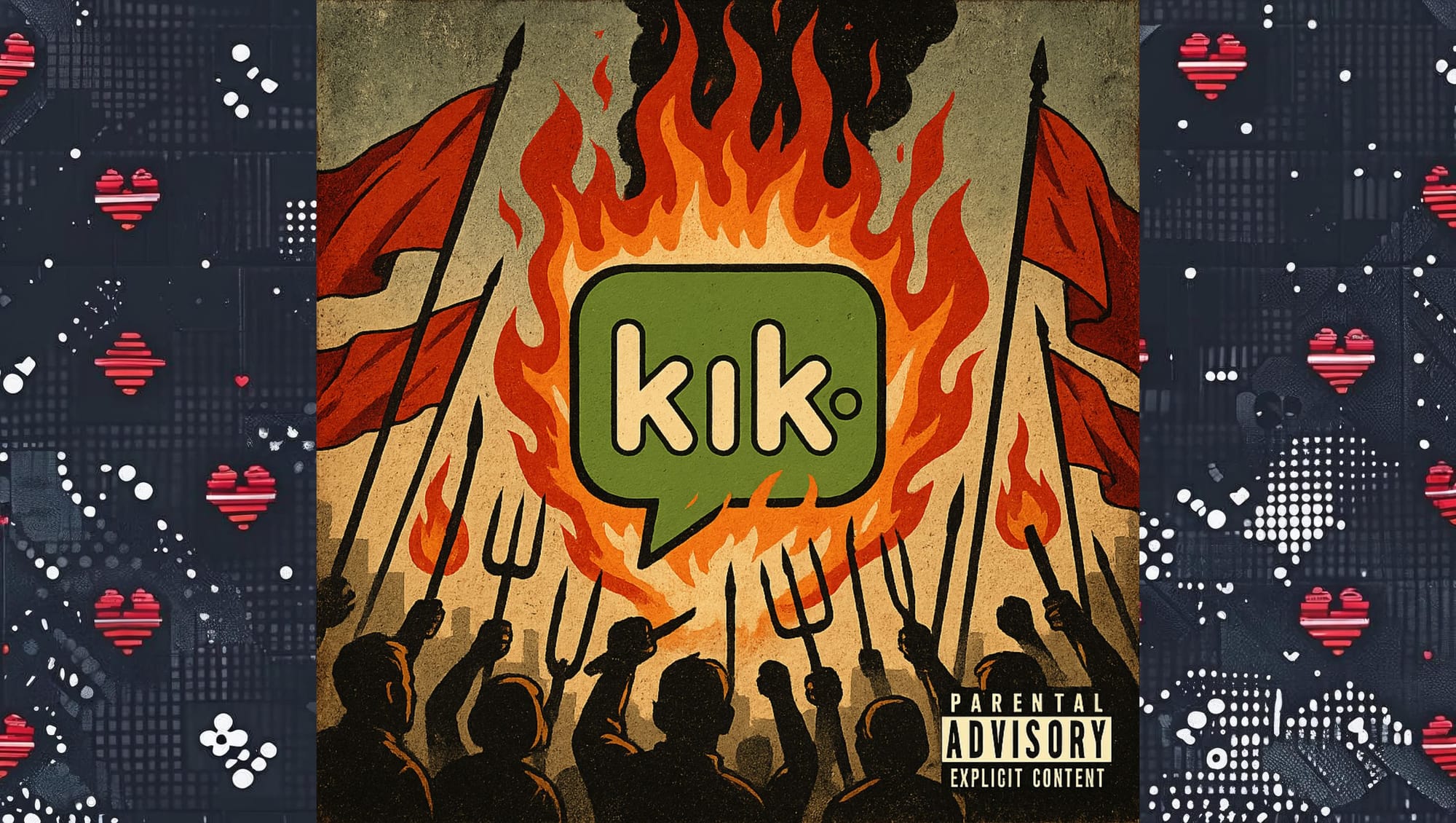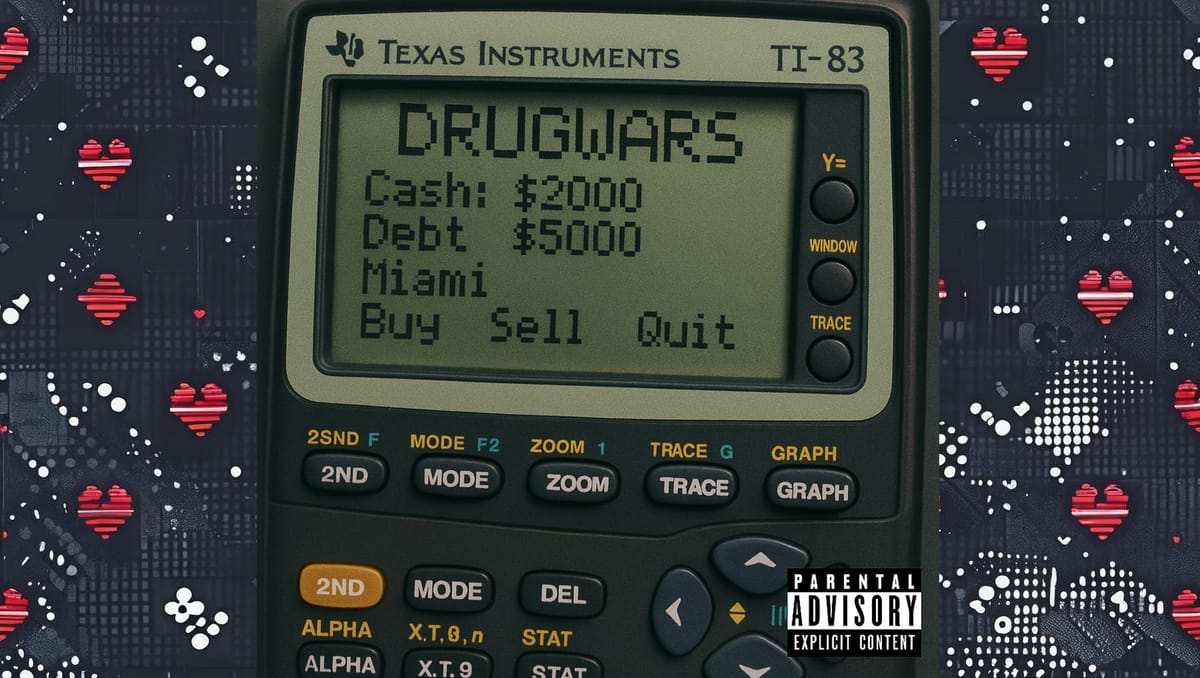Still Referring to Kik Is a Major Red Flag 🚩

Kik Was the Burner-App Era
Kik Messenger launched in 2010 and peaked roughly 2013–2016—a sweet spot for shadow-mode hookups fed by Craigslist personals, Backpage ads, and Tumblr threads.3 Kik’s value prop was anonymity: no phone number, just a username. That made it perfect for side conversations and disposable identities when SMS felt traceable, Facebook tied back to real names, and WhatsApp hadn’t fully crossed into U.S. mainstream yet.4
At the time, that frictionless anonymity felt revolutionary. It was the “burner” without buying a burner—quick, free, and deniable.5
Why Kik Fell Off
Predator problem. The same anonymity that made Kik fun made it dangerous. By the mid-2010s, it had a reputation for catfishing, scams, and underage predation cases—earning “dangerous app” lists from parenting orgs and press.6
Better burners arrived. Snapchat normalized disappearing messages;7 Telegram and Signal added encryption and groups;8 even Instagram DMs offered flexible messaging tied to real identities. Kik started to feel clunky and unsafe compared to tools that delivered discretion plus features.9
Cultural shift. In 2018, FOSTA-SESTA torched Craigslist personals, collapsing the “Kik me” pipeline that ran through those classifieds.10 People migrated to Feeld, FetLife, curated Telegram/Discord communities—spaces architected around consent and community rather than chaos.11
Why It’s a Red Flag in 2025
Out of touch. “Kik me” screams frozen-in-amber Craigslist/Backpage energy. It’s like bragging about your MySpace Top 8 in a TikTok world.12
Sketchy habits. Clinging to Kik often signals a desire to dodge accountability: disposable usernames, easy vanishing, no receipts. That’s a pattern, not a preference.13
Low social currency. Modern connection happens where community, consent, and identity scaffolding exist. If you’re still on Kik, you’re not inside the rooms where things actually move.14
What Replaced Kik
Feeld took the “raw honesty” of old personals and rebuilt it with design, safety, and explicit desire listing—normalizing polyamory/kink language and allowing people to be specific from the jump.15 It functions less like a hookup slot machine and more like a community platform with consent architecture.16
Telegram/Signal became the encrypted commons for kink, ENM, and local scenes—private groups, vetting, moderators, real consequences for bad behavior.17
Instagram DMs (normie, but effective) at least tie to persistent identity and social graph. If someone insists on anonymity when identity-tied channels are available, note the pattern.18
The Evolution of Digital Desire
Every era of hookup culture has a tech signature:
- Craigslist Casual Encounters (2000s): raw honesty, minimal safety net.19
- Kik (2010s): burner chat, shadow connections, disposable identities.20
- Feeld/Telegram/Discord (2020s): consent architecture, community, specificity.21
Sticking with Kik in 2025 isn’t nostalgia—it’s refusal to adapt. It clings to a hide-and-vanish model of connection rather than a build-and-belong model. That’s why the app itself is the tell: the tool encodes the intent.22
Modern Connection Demands More
If you’re serious—monogamous, poly, kinky, or experimental—you want signals of transparency, consent literacy, and community fluency. “Kik me” translates to: “I don’t want accountability,” “My habits haven’t updated since 2014,” and “I prefer disappearing acts to durable connection.”23
The MoneySexNerd Takeaway
MoneySexNerd decodes signals at the intersection of culture, sex, and tech. This one’s crystal: Kik is a museum piece. If someone is still waving it around, they’re stuck in the past, hiding something in the present, or cut off from the future. Treat it like the 🚩 it is.24
References & Notes
| Ref # | Term / Figure | Definition (1–3 sentences) | Source Link |
|---|---|---|---|
| 1 | Kik in 2025 | Kik Messenger persists but has largely lost mainstream cultural cachet; invoking it in dating contexts signals outdated habits. | Wikipedia — Kik Messenger |
| 2 | Craigslist Personals | Craigslist’s “Personals/Casual Encounters” were a major 2000s hub for anonymous hookups, later removed after 2018 legislation. | Wikipedia — Craigslist Personals |
| 3 | Kik Peak Era | Kik rose rapidly post-2010, popular among teens and subcultures for anonymity and ease of use. | Wikipedia — Kik |
| 4 | Real-Name vs. Anonymous | Facebook Messenger and early mainstream platforms tied to real identity; Kik allowed username-only accounts. | Wikipedia — Facebook Messenger |
| 5 | “Burner” Modality | “Burner” denotes disposable, low-identity channels (phones/apps) used to minimize traceability. | Wikipedia — Burner phone |
| 6 | Kik Safety Concerns | Kik repeatedly drew scrutiny from law enforcement and media regarding child safety and predation risks. | Wikipedia — Kik Controversies |
| 7 | Snapchat Ephemerality | Snapchat normalized disappearing messages and Stories, mainstreaming ephemeral communication. | Wikipedia — Snapchat |
| 8 | Telegram & Signal | Telegram and Signal provide encrypted messaging and group/community features, becoming hubs for niche scenes. | Wikipedia — Telegram • Wikipedia — Signal |
| 9 | Feature Gap | Compared with newer apps, Kik lagged in features that balanced discretion with safety and community management. | Wikipedia — Kik |
| 10 | FOSTA-SESTA (2018) | U.S. laws targeting online sex trafficking led platforms like Craigslist to remove personals sections. | Wikipedia — FOSTA-SESTA |
| 11 | Post-FOSTA Migration | Communities shifted toward platforms with clearer consent/community tooling (Feeld, Telegram, Discord, FetLife). | Wikipedia — Discord • FetLife (official) |
| 12 | MySpace Top 8 | MySpace’s “Top 8” is shorthand for dated internet culture; invoked here to signal temporal mismatch. | Wikipedia — MySpace |
| 13 | Accountability Signals | Identity-tied channels (e.g., IG DMs) encode light accountability; anonymous tools reduce traceability and consequences. | Wikipedia — Instagram |
| 14 | Social Currency | In dating/ENM/kink scenes, platform choice signals fluency with modern consent culture and community norms. | Wikipedia — Polyamory |
| 15 | Feeld: Design & Honesty | Feeld enables explicit desire listing, non-monogamy options, and community-minded discovery—modern successor to personals. | Feeld (official) |
| 16 | Feeld as Community | Feeld functions more like a social layer for alternative connection—emphasizing consent, specificity, and transparency. | Feeld (official) |
| 17 | Encrypted Group Commons | Telegram/Signal groups power local/interest-based communities with admin controls and invite-only culture. | Wikipedia — Telegram Features • Wikipedia — Signal Features |
| 18 | Identity-Tied DMs | Instagram’s messaging is attached to profiles and social graphs, offering soft verification via reputation. | Wikipedia — Instagram Messaging |
| 19 | Craigslist “Raw Honesty” | Casual Encounters allowed direct, unvarnished sexual communication—little moderation, high risk. | Wikipedia — Craigslist Personals |
| 20 | Kik’s Disposable Identity | Kik enabled low-friction, username-based contact—easy to create/abandon, facilitating transient encounters. | Wikipedia — Kik |
| 21 | Consent Architecture | Modern platforms implement features that foreground boundaries, roles, and expectations before meeting. | Feeld (official) |
| 22 | Tool Encodes Intent | Choosing anonymity-maximizing tools can signal avoidance of accountability; community tools signal engagement. | Wikipedia — Social software |
| 23 | Consent Literacy | Fluency with consent frameworks and non-monogamy etiquette is now baseline in many urban scenes. | Wikipedia — Consent (BDSM) |
| 24 | Museum Piece | Calling Kik a “museum piece” frames it as culturally obsolete—useful as a signal, not as a tool. | Wikipedia — Obsolescence |
| 25 | Blockbuster Gift Card Test | MSN shorthand: anachronistic behavior that timestamps someone in a bygone era (humorous diagnostic). | Wikipedia — Blockbuster |
MSN Lexicon Additions
- Kik Era (2010s): The burner-chat period of digital hookup culture, defined by anonymity, Craigslist/Backpage pipelines, and disposable usernames; eclipsed by consent-first community platforms in the 2020s. First used in Still Referring to Kik Is a Major Red Flag.
- Blockbuster Gift Card Test (2025): MoneySexNerd shorthand for diagnosing outdated behavior that timestamps a person’s habits (e.g., insisting on Kik in 2025). First used in Still Referring to Kik Is a Major Red Flag.



